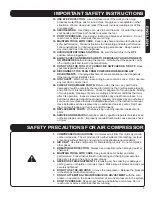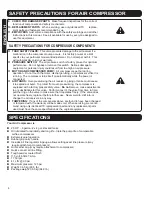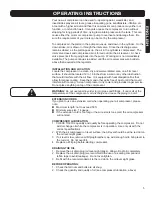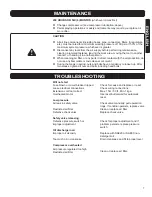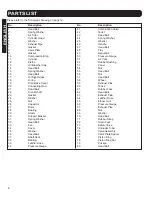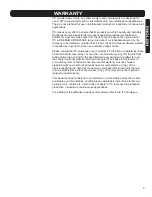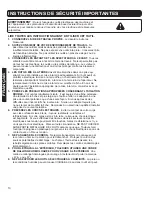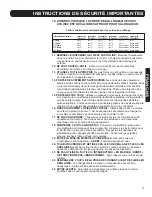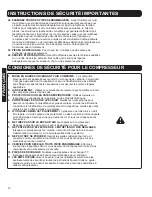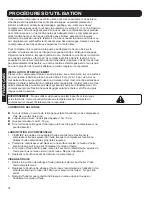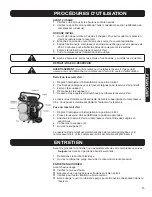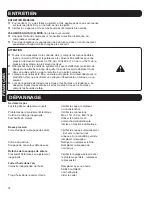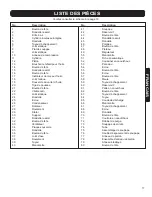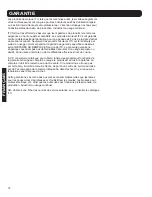
FRANÇAIS
ENGLISH
15. USE EYE PROTECTION.
Use a full-face mask
if the work you’re doing
produces metal filings, dust or wood chips.
Goggles are acceptable in other
situations. Wear a clean dust mask if the work involves creating a lot of fine
or coarse dust.
16. SECURE WORK.
Use clamps or a vise to hold the work. It’s safer than using
your hands and it frees both hands to operate the tool.
17. DON’T OVERREACH.
Keep proper footing and balance at all times. Do not
reach over or across machines that are running.
18. MAINTAIN TOOLS WITH CARE.
Keep tools sharp and clean for better and
safer performance. Follow instructions for lubricating and safe performance.
Follow instructions for lubricating and changing accessories. Keep handles
dry, clean and free from oil and grease.
19. AVOID UNINTENTIONAL STARTING.
Be sure the switch is in the
OFF
position before plugging in.
20. ALWAYS CHECK AND MAKE SURE TO REMOVE ANY ADJUSTING KEYS
OR WRENCHES
before turning the tool on. Left attached, these parts can fly
off a rotating part and result in personal injury.
21. DO NOT USE THE TOOL IF IT CANNOT BE SWITCHED ON OR OFF.
Have
your tool repaired before using it.
22. DISCONNNECT THE PLUG FROM POWER BEFORE MAKING ANY
ADJUSTMENTS.
Changing attachments or accessories can be dangerous
if the tool could accidentally start.
23. STAY ALERT.
Watch what you are doing & use common sense. Don’t operate
any tool when you are tired.
24. CHECK FOR DAMAGED PARTS.
Before using this tool, any part that is
damaged should be carefully checked to determine that it will operate properly
and perform its intended function. Check for alignment of moving parts, binding
of moving parts, breakage of parts, mountings, and other conditions that may
affect its operation. Inspect screws and tighten any ones that are loose. Any
part that is damaged should be properly repaired or replaced by an authorized
service center unless otherwise indicated elsewhere in the instruction manual.
Have defective switches replaced by an authorized service center. Don’t use
the tool if switch does not turn it on and off properly.
25. REPLACEMENT PARTS.
When servicing, use only identical replacement
parts.
26. SERVICE AND REPAIRS
should be made by qualified repair technicians at an
authorized repair centre. Improperly repaired tools could cause serious shock
or injury.
1. COMPRESSED AIR CAUTIONS:
Compressed air from this unit may contain
carbon monoxide. The air produced is neither suitable for breathing nor food
processing without filtering and testing to all applicable legal standards.
2. AIR ONLY:
Use this compressor for compressing air only. Do not compress
other gases.
3. BREATHING PROTECTION:
Always use a respirator when spraying paint or
chemicals.
4. MAINTAIN TOOLS WITH CARE.
Keep tools clean for better and safer
performance. Follow instructions for lubricating and changing accessories.
Keep dry, clean and free from oil and grease.
5. NEVER USE THIS EQUIPMENT
if it is leaking air; has missing or damaged
parts, guards, or shields; or requires repair. Make sure all screws and caps are
securely tightened.
6. DO NOT USE THE AIR HOSE
to move the compressor. Release the pressure
in the storage tank before moving.
7. DO NOT ATTEMPT ANY MAINTENANCE OR ADJUSTMENT
with the com
-
pressor in operation, the power connected, or air under pressure in the system.
8. DON’T OVERREACH.
Keep proper footing and balance at all times. Do not
reach over or across machines that are running.
IMPORTANT SAFETY INSTRUCTIONS
SAFETY PRECAUTIONS FOR AIR COMPRESSOR



